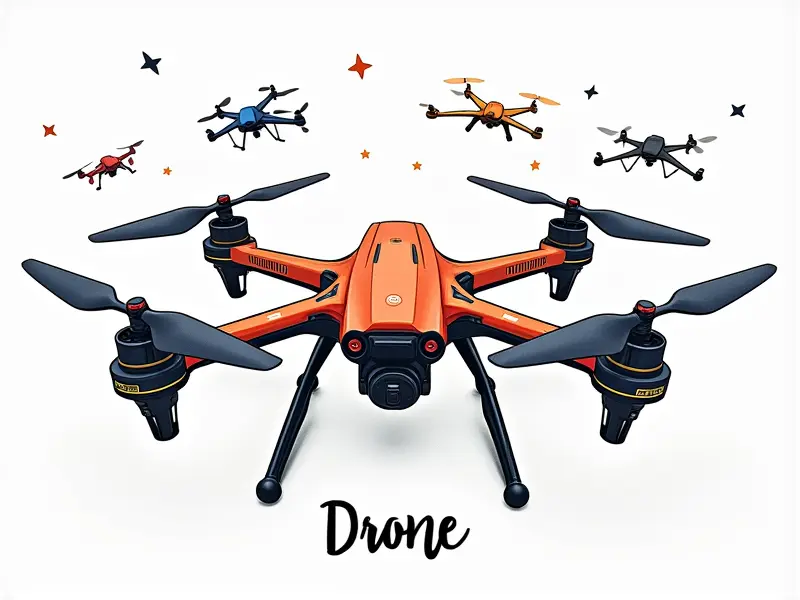Propeller pitch explained

Why Propeller Pitch Matters in Drone Racing
When it comes to drone racing, every detail counts for achieving optimal performance. One crucial factor that often gets overlooked is the propeller pitch. The pitch of a propeller determines how much air it displaces per revolution and directly affects the speed, efficiency, and stability of your quadcopter. Understanding and optimizing propeller pitch can give you the edge needed to outperform competitors.
Mastering Propeller Pitch for Optimal Speed
To master propeller pitch in drone racing, it's essential to understand its impact on speed and efficiency. A higher pitch setting will generate more lift and forward thrust but may require more power from the motors, leading to faster battery drain. Conversely, a lower pitch setting offers better maneuverability and extended flight times at the cost of reduced top speeds.
Experimenting with different propeller pitches can help you find the sweet spot that balances speed and endurance for your specific racing conditions.
Propeller Pitch: Key to Faster Drone Speeds
The pitch of a drone's propellers is one of the primary factors influencing its maximum achievable speed. By increasing the pitch, you enhance the forward thrust generated by each rotation, enabling faster acceleration and higher top speeds. However, this advantage comes at the expense of increased power consumption.
Choosing the right propeller pitch involves finding a balance between raw performance and practical considerations like battery life and maneuverability.
How Propeller Pitch Affects Quadcopter Performance
- Lift Generation: Higher pitch settings generate more lift, which is crucial for taking off quickly and maintaining altitude in windy conditions.
- Forward Thrust: Increased propeller pitch translates to greater forward thrust, allowing the quadcopter to reach higher speeds during races or long-distance flights.
- Battery Consumption: Higher pitch settings demand more power from the motors, leading to faster battery drain and reduced flight time.
The Role of Propeller Pitch in Quadcopters
In quadcopter design, propeller pitch plays a vital role in determining overall performance. It influences not only speed but also stability, maneuverability, and efficiency. A well-chosen pitch setting can enhance the quadcopter's ability to navigate through tight spaces or perform aerobatic maneuvers.
Optimizing Propeller Pitch for Quadcopters
To optimize propeller pitch for your quadcopter, consider the following factors:
- Racing Conditions: Adjust the pitch based on track characteristics and environmental conditions such as wind speed.
- Battery Capacity: Balance between desired speed and flight duration to ensure sufficient power for extended flights.
- Mechanical Components: Ensure that your motors, ESCs (Electronic Speed Controllers), and propellers are compatible with the chosen pitch setting.
Why Propeller Pitch Matters in RC Helicopters
Propeller pitch is equally critical for remote-controlled helicopters. It affects lift generation, maneuverability, and overall flight performance. Adjusting the pitch allows pilots to fine-tune their helicopter's responsiveness and stability, making it easier to perform complex aerial maneuvers.
Adjusting Propeller Pitch for Better Flight Control
To adjust propeller pitch effectively:
- Start Low: Begin with a lower pitch setting and gradually increase until you achieve the desired balance of lift and control.
- Tune in Stages: Make small adjustments and test each change to observe its impact on flight characteristics.
- Consider Load: Account for additional weight, such as cameras or sensors, when selecting an appropriate pitch setting.
Beginner's Guide to Propeller Pitch Adjustment
For beginners looking to understand propeller pitch adjustment, start by familiarizing yourself with basic principles and tools. Use a propeller pitch gauge to measure existing settings accurately before making adjustments.
Experimentation is key—try different pitches in controlled environments to see how they affect your quadcopter's performance.
The Basics of Propeller Pitch for Beginners
To grasp the basics of propeller pitch, consider these fundamental concepts:
- Pitch Definition: The angle at which a propeller blade is set relative to its rotation plane determines how much air it displaces per revolution.
- Influence on Lift and Thrust: Higher pitch settings generate more lift and thrust but require greater motor power, impacting battery life.
Understanding Propeller Pitch for FPV Racing
For first-person view (FPV) racing drones, propeller pitch optimization is crucial. FPV racers often prioritize top speed and quick acceleration over extended flight times. Experiment with higher pitch settings to maximize performance on race tracks.
Conclusion
Mastery of propeller pitch adjustment can significantly enhance the performance of your drone or RC helicopter, whether for racing, aerial photography, or other applications. By understanding how pitch affects lift generation, forward thrust, and overall efficiency, you can optimize your setup to achieve peak performance tailored to your specific needs.

